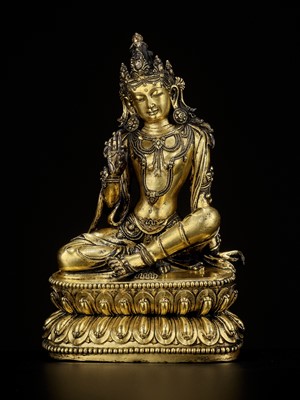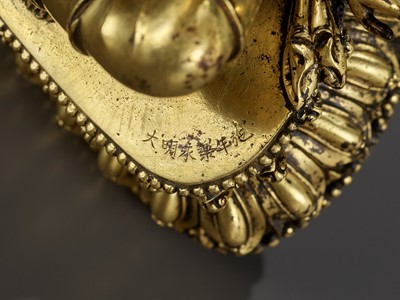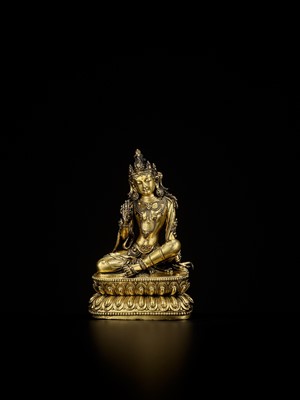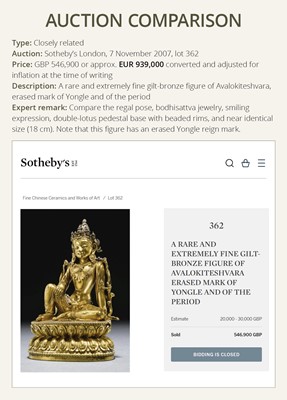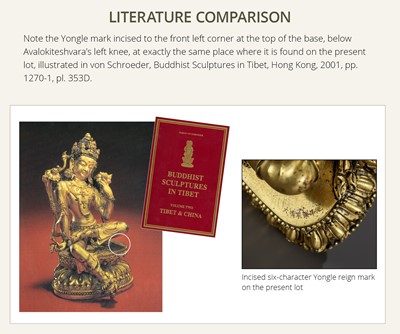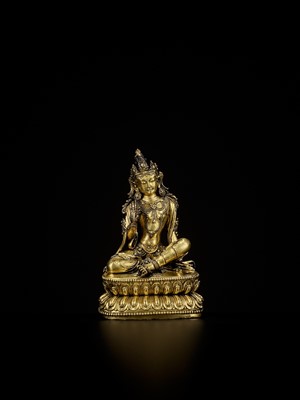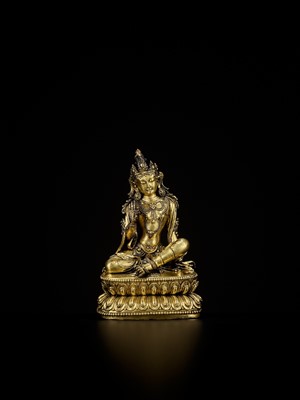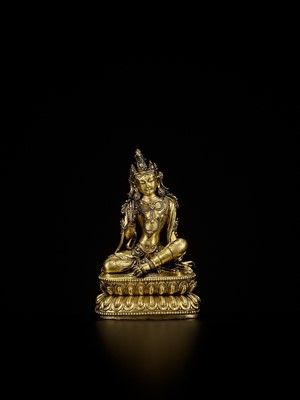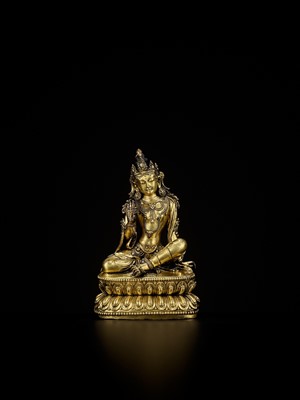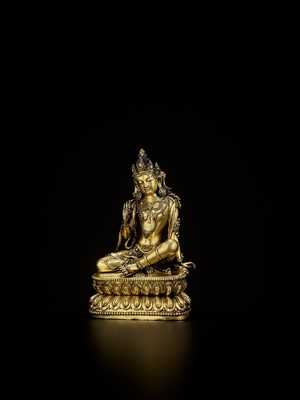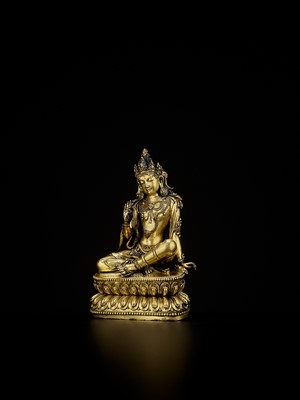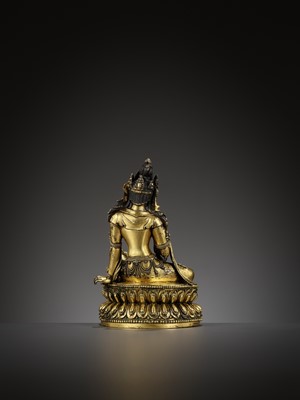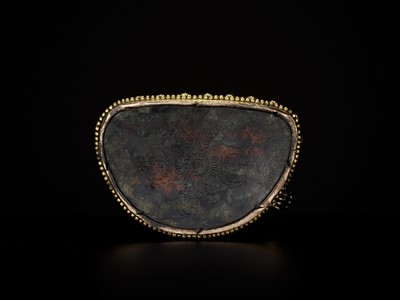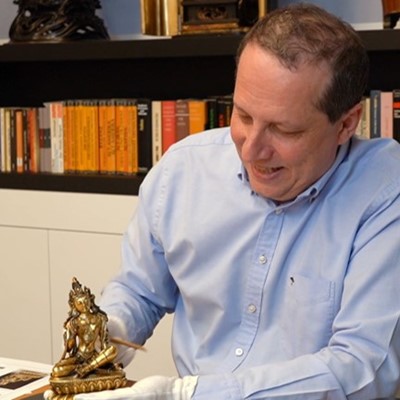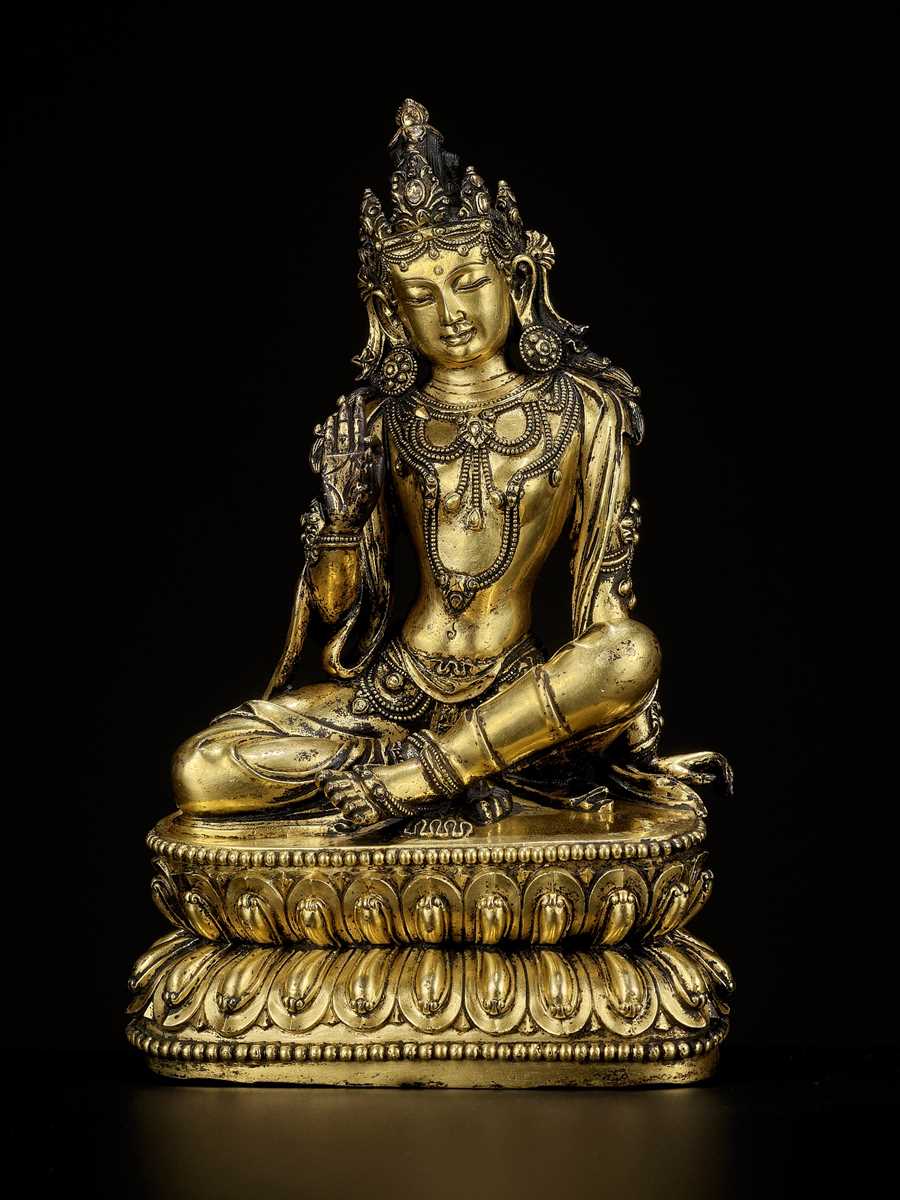9th Mar, 2023 13:00
TWO-DAY AUCTION - Fine Chinese Art / 中國藝術集珍 / Buddhism & Hinduism
160
AN EXTREMELY RARE GILT-BRONZE FIGURE OF AVALOKITESHVARA IN ROYAL EASE, YONGLE INCISED SIX-CHARACTER MARK AND OF THE PERIOD
永樂款罕見銅鎏金觀音
Sold for €143,000
including Buyer's Premium
China, 1402-1424. Superbly cast seated in rajalilasana, with swaying torso and head inclined, the left leg drawn up and the right folded in front, the left hand raised and held in vitarka mudra and the right elegantly resting on the rear of the double-lotus pedestal base with beaded rims. The front left corner at the top of the base is neatly incised with the six-character mark Da Ming Yongle nianzhi and of the period.
Provenance: From the private collection of a gentleman in the United Kingdom.
Condition: Superb condition with only minor wear, minimal casting flaws, minuscule nicks, and remnants of old varnish. The base retains the original sealing.
X-Ray Images: Available upon request.
Weight: 1,441 g
Dimensions: Height 17 cm
Expert’s remark: The present figure was in private ownership for a long time. Until just recently, it was covered entirely by a thick layer of old varnish, which had blackened completely over the years. The six-character mark was unrecognizably hidden under this coating, and the owner was unaware of its presence. A significant portion of the varnish has now been removed to reveal the magnificent original gilding hidden below. Needless to say, this was done in a most sensitive manner, without scratching the gilding, using only pure alcohol and cotton. There are still some remains of varnish, mostly in the many corners and recesses, which may also be removed if one wishes. Prospective bidders are encouraged to study our high-resolution images in full detail. These will confirm that most of the black areas remaining are ancient varnish, under which the gilding is well preserved.
The bodhisattva is wearing a finely detailed foliate tiara, a profusion of beaded jewels around the neck, arms, waist and ankles, a diaphanous scarf billowing at either side, and a voluminous lower garment gathered at the waist with a jeweled girdle and spreading onto the lotus pedestal. The face is exquisitely modeled to provide a benevolent expression with downcast eyes, gently arched brows, circular urna, and smiling lips. The neatly incised hair is drawn up into a knotted jatamakuta topped by a cintamani jewel and elegantly falling in tresses over the shoulders.
Bronzes in the Tibetan-Chinese style produced during the reign of Emperor Yongle in the first quarter of the 15th century and bearing his reign mark are highly distinguished for their unsurpassed craftsmanship, overall refinement and gracefulness. Executed by the Imperial ateliers, they display a highly consistent and uniform style, which evolved out of the influence of the Nepalese artist Anige (1244-1306) at the Yuan court and the close links with Tibet established by the Yongle Emperor. The distinct Imperial style includes double-lotus bases with beaded rims and characteristic facial features with broadened outline, gently arched brows above the lidded eyes and subtle smile, all finished with great attention to detail.
The future Yongle Emperor was likely introduced to Tibetan Buddhism and became interested in it around 1380, when he was enfeoffed in Beijing, and of course he had strong ties to the Mongol military elite, who were also adherents of lamaist Buddhism, so it appears that he continued to practice this form of Buddhism for the rest of his life. Certainly more works of art depicting lamaist Buddhist deities and imagery were produced during his reign period than under any other Chinese emperor, with the exception of the Qing Emperor Qianlong. For further discussion of this topic see J.C.Y. Watt and D.P. Leidy, Defining Yongle: Imperial Art in Early Fifteenth-Century China, Yale University Press, 2005.
In 1406, the Yongle Emperor sent a mission to Tibet inviting the famous hierarch of the Karmapa monastery, Halima, to Nanjing, to take part in the memorial services for the Hongwu Emperor and Empress Ma. Halima first sent a tribute mission, and then in the Spring of 1407 came to the Ming court in person. There he was received with great honor, given the title Dabao Fawang (Great Precious Religious Prince) and asked to perform religious ceremonies for the Emperor's deceased parents. After his return to Tibet, Halima continued to exchange gifts with the Emperor. The Yongle Emperor also invited the hierarch of the Sakyapa to the court at Nanjing in 1413 and treated him too with great honor. Thereafter missions were sent from Sakya abbots until the 1430s. A high-ranking representative of the Yellow Sect was invited to Nanjing in 1413 and was also greatly honored and returned to Tibet in 1416 with many gifts. Gifts and missions continued to be exchanged with the Yellow Sect until the 1430s.
Literature comparison:
Compare a closely related figure of Avalokiteshvara, also with the Yongle mark incised to the front left corner at the top of the base, below Avalokiteshvara’s left knee, at exactly the same place where it is found on the present lot, in the Norbulingka Palace in Lhasa, recorded by von Schroeder in his survey of the holdings of Tibetan monastery collections, illustrated in von Schroeder, Buddhist Sculptures in Tibet, Hong Kong, 2001, pp. 1270-1, pl. 353D, and in E. F. Lo Bue (ed.), Tesori del Tibet: Offetti d’arte dai Monasteri di Lhasa, 1994, p. 110, no. 70.
Auction result comparison:
Type: Closely related
Auction: Sotheby’s London, 7 November 2007, lot 362
Price: GBP 546,900 or approx. EUR 939,000 converted and adjusted for inflation at the time of writing
Description: A rare and extremely fine gilt-bronze figure of Avalokiteshvara, erased mark of Yongle and of the period
Expert remark: Compare the regal pose, bodhisattva jewelry, smiling expression, double-lotus pedestal base with beaded rims, and near identical size (18 cm). Note that this figure has an erased Yongle reign mark.
永樂款罕見銅鎏金觀音
中國,1402-1424年。觀音以轉輪王坐姿,神態閒適,坐於雙層蓮座上,左手撐在身後;右手施説法印,髮髻高挽,戴五葉寶冠,頭略低垂,上身袒裸,以連珠瓔珞裝飾,下身著裙,衣褶流暢,金色沉厚,蓮台座面上題刻“大明永樂年施”,為明宮廷風格的作品。
來源:英國一位紳士私人收藏。
品相:狀況極佳,只有輕微磨損、極小的鑄造缺陷、劃痕和舊清漆殘留。底座保留了原來的密封。
X光檢測圖片: 如有需可經詢問提供。
重量:1,441 克
尺寸:高17 厘米
專家注釋:本造像長期為私人所有。直到最近,它還完全覆蓋著一層厚厚的舊漆,多年來已經完全變黑。六字款就隱藏在這層塗層之下,面目全非,主人也渾然不覺。現在已經去除了很大一部分清漆,露出隱藏在下面的璀璨的原始鎏金。整個過程十分謹慎,沒有劃傷鎏金,只使用純酒精和棉花。在許多角落和凹處仍然有一些清漆殘留,如果願意,也可以將其去除。我們鼓勵投標人詳細研究所提供的高分辨率圖片。這些將證實剩下的大部分黑色區域是舊時清漆,鎏金在其下保護下保存極好。
十五世紀上半葉永樂帝在位期間製作的帶有年號漢藏風格青銅造像,工藝精湛,造像精緻優雅。它們由皇家工坊製作,呈現出高度統一的風格,這與元朝宮廷尼泊爾藝術家阿尼格(1244-1306 年)的影響以及永樂皇帝與西藏建立的密切聯繫有關。獨特的皇家風格包括雙蓮花底座、連珠邊和寬輪廓的面部特徵、眼瞼上方輕輕拱起的眉毛和含蓄的微笑。
永樂帝很可能在 1380 年左右對藏傳佛教產生興趣。當時他在北京受封,當然與他是藏傳佛教的蒙古將領有著密切的關係。在他統治期間創作的藏傳佛教造像等藝術作品比除清乾隆皇帝以外的任何其他中國皇帝都多。有關此主題的進一步討論,請參閱 J.C.Y. 瓦特和 D.頁Leidy,《Defining Yongle: Imperial Art in Early Fifteenth-Century China》,耶魯大學出版社,2005年。
1406年,永樂帝派使團入藏,邀請噶瑪巴寺著名法師哈利瑪來南京,參加洪武帝和馬皇后的葬禮。哈利瑪先是派進貢使團,又於1407年春親臨明朝。在那裡,他受到了隆重的接待,被授予大寶法王的稱號,並被要求為皇帝已故的父母舉行宗教儀式。回藏後,哈利瑪繼續與皇帝互贈禮物。1413年,永樂皇帝還邀請薩迦派教主到南京,並盛情款待。此後,直到 1430 年代,薩迦方丈一直派遣傳教士。1413年黃教應邀赴南京,1416年榮幸回藏,贈禮無數。直到 1430 年代,與黃教繼續交流。
文獻比較:
比較一件非常相近的鎏金銅觀音像,和我們的觀音像一樣,也是在蓮座上刻有永樂款,連位置都一樣,收藏於拉薩羅布林卡宮,紀錄於von Schroeder調查西藏寺院藏品時的記錄,見von Schroeder,《Buddhist Sculptures in Tibet》,香港,2001年,頁1270-1,圖353D,和E. F. Lo Bue編,《Tesori del Tibet: Offetti d’arte dai Monasteri di Lhasa》,1994年,頁110,編號70。
拍賣結果比較:
形制:非常相近
拍賣:倫敦蘇富比,2007年11月7日,lot 362
價格:GBP 546,900(相當於今日EUR 939,000)
描述:永樂款及年代鎏金銅觀音像
專家評論:比較轉輪王坐姿、佛教珠寶、微笑的表情,上翻蓮座飾珠,以及幾乎相同的尺寸 (18 厘米)。請注意此佛像的永樂款被抹去。
#byimperialcommand
China, 1402-1424. Superbly cast seated in rajalilasana, with swaying torso and head inclined, the left leg drawn up and the right folded in front, the left hand raised and held in vitarka mudra and the right elegantly resting on the rear of the double-lotus pedestal base with beaded rims. The front left corner at the top of the base is neatly incised with the six-character mark Da Ming Yongle nianzhi and of the period.
Provenance: From the private collection of a gentleman in the United Kingdom.
Condition: Superb condition with only minor wear, minimal casting flaws, minuscule nicks, and remnants of old varnish. The base retains the original sealing.
X-Ray Images: Available upon request.
Weight: 1,441 g
Dimensions: Height 17 cm
Expert’s remark: The present figure was in private ownership for a long time. Until just recently, it was covered entirely by a thick layer of old varnish, which had blackened completely over the years. The six-character mark was unrecognizably hidden under this coating, and the owner was unaware of its presence. A significant portion of the varnish has now been removed to reveal the magnificent original gilding hidden below. Needless to say, this was done in a most sensitive manner, without scratching the gilding, using only pure alcohol and cotton. There are still some remains of varnish, mostly in the many corners and recesses, which may also be removed if one wishes. Prospective bidders are encouraged to study our high-resolution images in full detail. These will confirm that most of the black areas remaining are ancient varnish, under which the gilding is well preserved.
The bodhisattva is wearing a finely detailed foliate tiara, a profusion of beaded jewels around the neck, arms, waist and ankles, a diaphanous scarf billowing at either side, and a voluminous lower garment gathered at the waist with a jeweled girdle and spreading onto the lotus pedestal. The face is exquisitely modeled to provide a benevolent expression with downcast eyes, gently arched brows, circular urna, and smiling lips. The neatly incised hair is drawn up into a knotted jatamakuta topped by a cintamani jewel and elegantly falling in tresses over the shoulders.
Bronzes in the Tibetan-Chinese style produced during the reign of Emperor Yongle in the first quarter of the 15th century and bearing his reign mark are highly distinguished for their unsurpassed craftsmanship, overall refinement and gracefulness. Executed by the Imperial ateliers, they display a highly consistent and uniform style, which evolved out of the influence of the Nepalese artist Anige (1244-1306) at the Yuan court and the close links with Tibet established by the Yongle Emperor. The distinct Imperial style includes double-lotus bases with beaded rims and characteristic facial features with broadened outline, gently arched brows above the lidded eyes and subtle smile, all finished with great attention to detail.
The future Yongle Emperor was likely introduced to Tibetan Buddhism and became interested in it around 1380, when he was enfeoffed in Beijing, and of course he had strong ties to the Mongol military elite, who were also adherents of lamaist Buddhism, so it appears that he continued to practice this form of Buddhism for the rest of his life. Certainly more works of art depicting lamaist Buddhist deities and imagery were produced during his reign period than under any other Chinese emperor, with the exception of the Qing Emperor Qianlong. For further discussion of this topic see J.C.Y. Watt and D.P. Leidy, Defining Yongle: Imperial Art in Early Fifteenth-Century China, Yale University Press, 2005.
In 1406, the Yongle Emperor sent a mission to Tibet inviting the famous hierarch of the Karmapa monastery, Halima, to Nanjing, to take part in the memorial services for the Hongwu Emperor and Empress Ma. Halima first sent a tribute mission, and then in the Spring of 1407 came to the Ming court in person. There he was received with great honor, given the title Dabao Fawang (Great Precious Religious Prince) and asked to perform religious ceremonies for the Emperor's deceased parents. After his return to Tibet, Halima continued to exchange gifts with the Emperor. The Yongle Emperor also invited the hierarch of the Sakyapa to the court at Nanjing in 1413 and treated him too with great honor. Thereafter missions were sent from Sakya abbots until the 1430s. A high-ranking representative of the Yellow Sect was invited to Nanjing in 1413 and was also greatly honored and returned to Tibet in 1416 with many gifts. Gifts and missions continued to be exchanged with the Yellow Sect until the 1430s.
Literature comparison:
Compare a closely related figure of Avalokiteshvara, also with the Yongle mark incised to the front left corner at the top of the base, below Avalokiteshvara’s left knee, at exactly the same place where it is found on the present lot, in the Norbulingka Palace in Lhasa, recorded by von Schroeder in his survey of the holdings of Tibetan monastery collections, illustrated in von Schroeder, Buddhist Sculptures in Tibet, Hong Kong, 2001, pp. 1270-1, pl. 353D, and in E. F. Lo Bue (ed.), Tesori del Tibet: Offetti d’arte dai Monasteri di Lhasa, 1994, p. 110, no. 70.
Auction result comparison:
Type: Closely related
Auction: Sotheby’s London, 7 November 2007, lot 362
Price: GBP 546,900 or approx. EUR 939,000 converted and adjusted for inflation at the time of writing
Description: A rare and extremely fine gilt-bronze figure of Avalokiteshvara, erased mark of Yongle and of the period
Expert remark: Compare the regal pose, bodhisattva jewelry, smiling expression, double-lotus pedestal base with beaded rims, and near identical size (18 cm). Note that this figure has an erased Yongle reign mark.
永樂款罕見銅鎏金觀音
中國,1402-1424年。觀音以轉輪王坐姿,神態閒適,坐於雙層蓮座上,左手撐在身後;右手施説法印,髮髻高挽,戴五葉寶冠,頭略低垂,上身袒裸,以連珠瓔珞裝飾,下身著裙,衣褶流暢,金色沉厚,蓮台座面上題刻“大明永樂年施”,為明宮廷風格的作品。
來源:英國一位紳士私人收藏。
品相:狀況極佳,只有輕微磨損、極小的鑄造缺陷、劃痕和舊清漆殘留。底座保留了原來的密封。
X光檢測圖片: 如有需可經詢問提供。
重量:1,441 克
尺寸:高17 厘米
專家注釋:本造像長期為私人所有。直到最近,它還完全覆蓋著一層厚厚的舊漆,多年來已經完全變黑。六字款就隱藏在這層塗層之下,面目全非,主人也渾然不覺。現在已經去除了很大一部分清漆,露出隱藏在下面的璀璨的原始鎏金。整個過程十分謹慎,沒有劃傷鎏金,只使用純酒精和棉花。在許多角落和凹處仍然有一些清漆殘留,如果願意,也可以將其去除。我們鼓勵投標人詳細研究所提供的高分辨率圖片。這些將證實剩下的大部分黑色區域是舊時清漆,鎏金在其下保護下保存極好。
十五世紀上半葉永樂帝在位期間製作的帶有年號漢藏風格青銅造像,工藝精湛,造像精緻優雅。它們由皇家工坊製作,呈現出高度統一的風格,這與元朝宮廷尼泊爾藝術家阿尼格(1244-1306 年)的影響以及永樂皇帝與西藏建立的密切聯繫有關。獨特的皇家風格包括雙蓮花底座、連珠邊和寬輪廓的面部特徵、眼瞼上方輕輕拱起的眉毛和含蓄的微笑。
永樂帝很可能在 1380 年左右對藏傳佛教產生興趣。當時他在北京受封,當然與他是藏傳佛教的蒙古將領有著密切的關係。在他統治期間創作的藏傳佛教造像等藝術作品比除清乾隆皇帝以外的任何其他中國皇帝都多。有關此主題的進一步討論,請參閱 J.C.Y. 瓦特和 D.頁Leidy,《Defining Yongle: Imperial Art in Early Fifteenth-Century China》,耶魯大學出版社,2005年。
1406年,永樂帝派使團入藏,邀請噶瑪巴寺著名法師哈利瑪來南京,參加洪武帝和馬皇后的葬禮。哈利瑪先是派進貢使團,又於1407年春親臨明朝。在那裡,他受到了隆重的接待,被授予大寶法王的稱號,並被要求為皇帝已故的父母舉行宗教儀式。回藏後,哈利瑪繼續與皇帝互贈禮物。1413年,永樂皇帝還邀請薩迦派教主到南京,並盛情款待。此後,直到 1430 年代,薩迦方丈一直派遣傳教士。1413年黃教應邀赴南京,1416年榮幸回藏,贈禮無數。直到 1430 年代,與黃教繼續交流。
文獻比較:
比較一件非常相近的鎏金銅觀音像,和我們的觀音像一樣,也是在蓮座上刻有永樂款,連位置都一樣,收藏於拉薩羅布林卡宮,紀錄於von Schroeder調查西藏寺院藏品時的記錄,見von Schroeder,《Buddhist Sculptures in Tibet》,香港,2001年,頁1270-1,圖353D,和E. F. Lo Bue編,《Tesori del Tibet: Offetti d’arte dai Monasteri di Lhasa》,1994年,頁110,編號70。
拍賣結果比較:
形制:非常相近
拍賣:倫敦蘇富比,2007年11月7日,lot 362
價格:GBP 546,900(相當於今日EUR 939,000)
描述:永樂款及年代鎏金銅觀音像
專家評論:比較轉輪王坐姿、佛教珠寶、微笑的表情,上翻蓮座飾珠,以及幾乎相同的尺寸 (18 厘米)。請注意此佛像的永樂款被抹去。
#byimperialcommand
Zacke Live Online Bidding
Our online bidding platform makes it easier than ever to bid in our auctions! When you bid through our website, you can take advantage of our premium buyer's terms without incurring any additional online bidding surcharges.
To bid live online, you'll need to create an online account. Once your account is created and your identity is verified, you can register to bid in an auction up to 12 hours before the auction begins.
Intended Spend and Bid Limits
When you register to bid in an online auction, you will need to share your intended maximum spending budget for the auction. We will then review your intended spend and set a bid limit for you. Once you have pre-registered for a live online auction, you can see your intended spend and bid limit by going to 'Account Settings' and clicking on 'Live Bidding Registrations'.
Your bid limit will be the maximum amount you can bid during the auction. Your bid limit is for the hammer price and is not affected by the buyer’s premium and VAT. For example, if you have a bid limit of €1,000 and place two winning bids for €300 and €200, then you will only be able to bid €500 for the rest of the auction. If you try to place a bid that is higher than €500, you will not be able to do so.
Online Absentee and Telephone Bids
You can now leave absentee and telephone bids on our website!
Absentee Bidding
Once you've created an account and your identity is verified, you can leave your absentee bid directly on the lot page. We will contact you when your bids have been confirmed.
Telephone Bidding
Once you've created an account and your identity is verified, you can leave telephone bids online. We will contact you when your bids have been confirmed.
Classic Absentee and Telephone Bidding Form
You can still submit absentee and telephone bids by email or fax if you prefer. Simply fill out the Absentee Bidding/Telephone bidding form and return it to us by email at office@zacke.at or by fax at +43 (1) 532 04 52 20. You can download the PDF from our Upcoming Auctions page.
How-To Guides
How to Create Your Personal Zacke Account
How to Register to Bid on Zacke Live
How to Leave Absentee Bids Online
How to Leave Telephone Bids Online
中文版本的操作指南
创建新账号
注册Zacke Live在线直播竞拍(免平台费)
缺席投标和电话投标
Third-Party Bidding
We partner with best-in-class third-party partners to make it easy for you to bid online in the channel of your choice. Please note that if you bid with one of our third-party online partners, then there will be a live bidding surcharge on top of your final purchase price. You can find all of our fees here. Here's a full list of our third-party partners:
- 51 Bid Live
- EpaiLive
- ArtFoxLive
- Invaluable
- LiveAuctioneers
- the-saleroom
- lot-tissimo
- Drouot
Please note that we place different auctions on different platforms. For example, in general, we only place Chinese art auctions on 51 Bid Live.
Bidding in Person
You must register to bid in person and will be assigned a paddle at the auction. Please contact us at office@zacke.at or +43 (1) 532 04 52 for the latest local health and safety guidelines.
